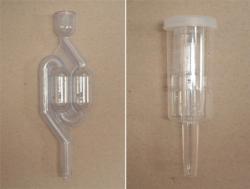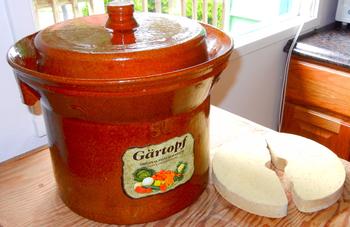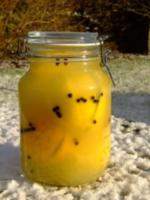Fermentation
Fermentation is one of humankind's oldest food preservation practices. Wine, beer, bread, tofu, and sauerkraut are all fermented foods. The overall idea of fermentation is to use microorganisms to modify foods to improve food safety.
Wine, cider, mead, and beer use yeast for fermentation. While these products are not the focus of our program, we can provide this information on producing cider safely.
Unfortunately there are more forms of fermentation than we can provide reputable information for home cooks. As we gather resources, we will present them here. If you don't see what you are looking for, contact us at immg@ucanr.edu and we may be able to provide a tested recipe for you.
Some information is presented below that may be helpful.
Lacto-Fermentation
Lacto-fermentation utilizes bacteria to ferment food in an environment free of oxygen. These bacteria acidify foods and add a characteristic flavor to the products.
Common fermented foods include sauerkraut and fermented dill pickles. (Links go to recipes.)
Lacto-fermented foods should be stored in the refrigerator, however, there is a tested recipe to water-bath can sauerkraut for non-refrigerated storage. It is available here.
Some things to remember when following these recipes:
- Always use pure salt without anti-caking agents. Kosher salt is usually a good choice. Check the ingredients and it should just say: Salt.
- There is no reason to use fancy gourmet salts. The flavors of the other ingredients will overwhelm any subtleties of those salts.
- Temperature during fermentation has an affect of the flavor and texture of the final product. Try to match the recommended temperatures.
- You can make less than 25 pounds of sauerkraut at a time. The recipe can be sized smaller.
Suitable Containers, Covers and Weights for Fermenting Food
A 1-gallon container is needed for each 5 pounds of fresh vegetables. Therefore, a 5-gallon stone crock is of ideal size for fermenting about 25 pounds of fresh cabbage or cucumbers. Food-grade plastic and glass containers are excellent substitutes for stone crocks. Other 1- to 3-gallon non-food-grade plastic containers may be used if lined inside with a clean food-grade plastic bag. Caution: Be certain that foods contact only food-grade plastics. Do not use garbage bags or trash liners. Fermenting sauerkraut in quart and half-gallon Mason jars is an acceptable practice, but may result in more spoilage losses.
Cabbage and cucumbers must be kept 1 to 2 inches under brine while fermenting. After adding prepared vegetables and brine, insert a suitably sized dinner plate or glass pie plate inside the fermentation container. The plate must be slightly smaller than the container opening, yet large enough to cover most of the shredded cabbage or cucumbers. To keep the plate under the brine, weight it down with 2 to 3 sealed quart jars filled with water. Covering the container opening with a clean, heavy bath towel helps to prevent contamination from insects and molds while the vegetables are fermenting. Fine quality fermented vegetables are also obtained when the plate is weighted down with a very large clean, plastic bag filled with 3 quarts of water containing 4-1/2 tablespoons of salt. Be sure to seal the plastic bag. Freezer bags sold for packaging turkeys are suitable for use with 5-gallon containers.
The fermentation container, plate, and jars must be washed in hot sudsy water, and rinsed well with very hot water before use.
Fermentation Locks
Lacto-fermentation occurs in an environment without oxygen. Oxygen encourages the development of kahm yeast (harmless but can affect results), molds, and poor quality, contaminated ferments. Fermentation locks keep oxygen out and encourage better results. We recommend their use.
A fermentation lock is a device that allows fermentation gasses to exit a container, but keeps gasses like oxygen from entering. Brewers and winemakers use fermentation locks extensively.
It is entirely possible to produce fermented products without a fermentation lock by using enough salt and keeping the fermentation submerged with a weight, but there is a higher risk of something going wrong. Without a lock, it is normal to have to remove kahm yeast from the brine.
This is a quick review of fermentation lock options.
Brewers Locks

These usually are 3-piece locks or and S-shaped tube with saline water acting as the barrier to gasses when we lactoferment. They can be glass, but usually are plastic.
These are very effective and are easy to find. These locks are available at brewing and winemaking suppliers.
You will need a screw-on lid to your container with hole in the top for the apparatus. Usually a food-grade stopper with a hole is put into the lid, and the fermentation lock fits into the stopper. You can find lids with a silicone grommet built in that serve the same purpose.
MFP Volunteers have had excellent success with this type of lock. Failure is highly unusual.
Caps with Integrated Locks
These are effective at keeping air out, but some models are hard to clean after and during use. Look for versions that can be disassembled for cleaning. It is common for lacto-fermented products to “surge” with fluid 2 to 4 days after the process starts. These types of locks often lack capacity deal with any surge so any fluid that rises from the top can spill over the top of the lid. This doesn’t affect fermentation, but you will want to be sure you have a plate or towel underneath to catch extra fluid. This can happen with any type of lock, but it seems easier with integrated caps.
The quality of caps with integrated locks varies tremendously by type and manufacturer. The rule “you get what you pay for” probably applies here. Some lids are little more than nipples for baby bottles or simple flaps. These may not be adequate for longer ferments like sauerkraut, but they are probably better than not using any lock.
Weighted Lids With Liquid Rims
Some crocks have weighted lids that fit into a groove along the rim. This rim is filled with saline water. You may encounter lids for jars that use this principle. The container and the lid are designed to work together. While this works, we have observed kahm yeast growing in the rim and on the surface of the brine. We had had more failures with this system than others. These are usually found on larger containers like sauerkraut crocks. If you use these, be sure to fill the container fully and use a weight to keep the cabbage submerged fully. Make sure the brine in the groove is sufficiently saline.

Having problems fermenting?
Consult this source for information on fermentation problems.
Preserved Lemons

Preserved lemons are common in north African and southeast Asian cuisines. Anything that could benefit from fresh lemon flavor and salt, can usually benefit from adding preserved lemons. Try them with eggs or roast for a nice treat.
Oranges or limes may be substituted, but note that limes will not retain a green color.
Recipe
- 5 to 7 fresh lemons
- 2 oz pure kosher or canning salt by weight, divided
- Dried spices to taste (optional)
- 1 pint mason jar with lid
- Wash lemons well to remove dirt. Cut a small amount (1/8 – 1/4 inch) from the stem end. From stem end, cut 3 to 5 lemons into quarters. Juice remaining lemons.
- Sprinkle approximately 1/3 of the salt over the bottom of the jar. Working over a bowl or cutting board, pack 4 quarters of lemon (1 entire lemon) into the jar. Sprinkle another 1/3 of the salt over the first lemon. Pack another quartered lemon into the jar and sprinkle remaining salt over lemons. Continue to add quartered lemon slices until jar is full to within 1/2 inch of the top.
- Fill jar with lemon juice to 1/2 inch of the top. Screw on lid fingertip tight. Shake vigorously for 30 seconds. If necessary, top off jar with lemon juice to 1/2 inch of the top.
- Place jar in a dark, cool storage area for 2 weeks, shaking daily until salt dissolves and shaking occasionally thereafter. After 2 weeks, the preserved lemons are ready to use.
- For best flavor, store in the refrigerator and use within 6 months.
Bread
Naturally Leavened Bread
Many breads are produced through fermentation. Fermentation by yeasts is used to leaven loaves so they rise, and sourdoughs also utilize bacteria to acidify dough to add that characteristic sour flavor.
Yeast breads typically use commercially prepared baker's yeast (Saccharomyces cerevisiae) added to the dough and allowed to rise before baking. Yeast convert sugars in the dough to alcohol and carbon dioxide. Yeast bread recipes are numerous and easy to find on the Internet and present little food safety risk after baking.
Sourdough breads are leavened with wild yeast and also contain bacteria that acidify dough adding their characteristic sour punch. Again, recipes are easy to find.
Bakers who make sourdough breads maintain a starter that keeps the microorganisms alive between batches. Most bakers obtain starter from a fellow baker. Since sourdough starter is alive, there is a small risk of things going wrong, including a starter getting contaminated. Colorado State Extension has some information on maintaining a starter safely.
Adjusting Yeast Bread Recipes for High Altitude
The Owens Valley is high enough in elevation to affect most baking recipes. Residents even higher in places like Mammoth Lakes or Lee Vining are affected even more strongly. Generally speaking rising is more "potent" than at lower elevations. Colorado State Extension offers this advice:
High altitude has its most pronounced effect on the rising time of bread. The shortened rise period can interfere with flavor development, thus less yeast may be used or the dough may be punched down, allowed to rise a second time, and punched down again before molding into loaves or rolls. Watch carefully to prevent over-rising. Allow dough to rise until just double in bulk, as over-proofing can result in a heavy, dry loaf or misshapen or collapsed loaf.
Flours tend to be drier and thus able to absorb more liquid in high, dry climates. Therefore, less flour or possibly additional liquid may be needed to moisten the dough to the proper consistency.
It's hard to quantify exactly how you may need to alter a recipe or rising time for each location. The best solution is to make a good estimate and see how it works. Keep notes in a journal. After a few tries, you will better understand how dough behaves in your location.
